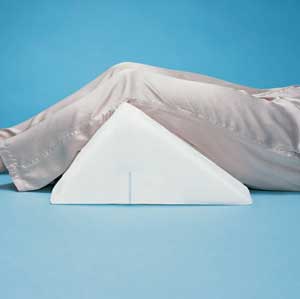

Let us face it—if you have spent more than an hour hunched over a desk, chances are your neck is plotting revenge.
The modern work setup, complete with screens, keyboards, and endless Zoom calls, is a breeding ground for poor posture. And while we have got standing desks and lumbar supports for our backs, our poor necks are often left hanging—literally.
That is where neck wedges come in. These deceptively simple foam supports are designed to realign your cervical spine, reduce neck strain, and retrain your muscles to hold your head high.
No wizardry involved—just smart design and body science.
In this guide, Best Forward Head Posture Fix would take a step-by-step journey into how neck wedges can support posture correction during desk work.
We would break down what they are, how to use them, and why they work so well for tech neck and forward head syndrome.
Time to give your neck the VIP treatment it’s been begging for.
The Culprit: Desk Work and Forward Head Posture
Sitting for long hours at a desk sounds innocent—until you realize your neck’s taking the brunt of it.
Most of us unconsciously lean forward to read our screens, check our phones, or scribble notes. This creates a condition known as forward head posture, where your head juts out in front of your shoulders.
Not only does this shift increase the gravitational load on your cervical spine, but it also overstretches the muscles at the back of your neck while shortening the ones in front.
Over time, this muscle imbalance leads to chronic tension, reduced neck mobility, and that dreadful feeling like your head’s a bowling ball.
It does not help that desk chairs often lack upper-back support and computer monitors are placed too low.
Left unchecked, this posture can even lead to headaches, shoulder pain, and long-term disc problems.
Enter neck wedges—a targeted fix for a problem created one Zoom call at a time.
Meet the Neck Wedge: Small Tool, Big Mission
A neck wedge may not look like much—it is basically a firm, angled foam block. But do not let its simplicity fool you.
This orthopedic tool is shaped to cradle the natural curve of your cervical spine, gently nudging it back into alignment. Think of it like a mold that encourages your neck to rediscover its proper posture.
While most pillows are designed for sleep, the neck wedge is used while lying down during short sessions to counteract the daily wear-and-tear from poor desk posture.
Its sloped design helps decompress vertebrae, relax tight muscles, and reestablish the head’s ideal position over the shoulders.
Most wedges are made of high-density foam for firm support, with some models even offering memory foam comfort.
The real magic?
It lets gravity do the work. By lying back on the wedge, your spine unwinds passively, taking pressure off overworked tissues.
So, wedge pillows re-align cervical spine in a natural way.
It is like hitting the reset button for your neck.
Step One: Positioning the Wedge Correctly
First things first—you cannot reap the benefits of a neck wedge if you use it incorrectly. To get started, find a quiet space and lie flat on your back—either on the floor, yoga mat, or a firm mattress.
Place the wedge under your neck so that the thicker end is under the base of your skull and the thinner end supports your upper spine. Your head should not tilt backward excessively or feel unsupported; instead, you should feel gently cradled.
Make sure your shoulders are relaxed and flat against the floor. The goal is to let your neck settle into its natural curve—not to force it into a stiff position. Stay in this setup for about 10 to 15 minutes.
In the beginning, it may feel unusual, especially if you have been slouching for years, but this alignment is what your neck is designed for. It is passive therapy that feels like a break.
Step Two: Passive Realignment Without Strain
Once you’re lying on the wedge, something amazing happens—you begin to feel your neck relax into a more neutral posture.
No stretches, no effort, just gravity doing its job. This passive realignment is crucial for people whose necks have adapted to poor positions.
Unlike active stretches that may strain weak or tight muscles, a neck wedge offers gentle coaxing to fix the curve in your neck by promoting optimal alignment. Your head gradually retracts into a position directly over your shoulders, rather than hanging forward like a pendulum.
This realignment reduces tension in the suboccipital muscles, which are often responsible for tension headaches and neck pain. It also helps decompress cervical discs, which get compressed from prolonged forward head posture.
Think of it like resetting your iPhone—sometimes the system just needs a soft reboot. With repeated use, your neck muscles begin to “remember” what good posture feels like, making it easier to maintain upright form during desk work.
Step Three: Retraining Muscles Through Consistency
The real magic of using a neck wedge is not just in one-time use—it is in the habit.
By consistently lying on the wedge, your muscles start retraining themselves.
Why does this matter?
Because posture is not just about bones—it is about muscle memory. When you hold your head forward all day, your muscles adapt to that position, even if it is harmful. The wedge gently shifts those muscle lengths and tensions back to their natural state.
Over time, anterior neck muscles like the longus colli strengthen, while overworked posterior muscles such as the upper traps begin to relax. Incorporating wedge pillow into exercises is also advisable to fix spinal posture.
This balance helps support your head upright with less effort. Think of it like teaching your body to ride a bike again—but for posture.
A few sessions a day, about 10 to 15 minutes each, can help you re-establish control over your cervical alignment without needing to think about it constantly. It is posture rehab, no sweat required.
Step Four: Enhancing Blood Flow and Nervous System Balance
When your neck is misaligned, it is not just muscles that suffer—circulation and nerve function can take a hit too.
Poor posture can compress blood vessels and irritate spinal nerves in the cervical region, leading to symptoms like tingling arms, dizziness, or headaches. Using a neck wedge can relieve some of this compression.
As your neck returns to a more neutral curve, the space between vertebrae opens slightly, allowing for improved blood flow to your brain and upper limbs.
At the same time, reduced muscle tension lowers the body’s stress response.
Some users report feeling calmer or less anxious after wedge use—and there is a physiological reason. Your vagus nerve, which helps regulate relaxation, runs through your neck.
Freeing it from tension may enhance its function.
So this isn’t just a “fix your neck” device—it is also a “calm your nervous system” tool.
Who knew posture correction could double as a mood booster?
Step Five: Supporting Exercise and Stretching Routines
Neck wedges are not just a standalone tool—they also work wonderfully as part of a broader mobility and strengthening routine.
For example, performing chin tucks, shoulder blade squeezes, or wall angels becomes easier and more effective after using the wedge.
Why?
Because your neck is already aligned, reducing compensations during these exercises.
It is like trying to do yoga after a massage—you move better because tension has been released. A daily posture routine might include using the wedge for 10 minutes, followed by active stretching, and finishing with a few strengthening exercises.
Over time, this builds endurance in the neck and upper back muscles, which helps you hold better posture even while seated at a desk.
Think of the wedge as your warm-up tool that resets your base so you can exercise smarter. It sets the stage for long-term change rather than just short-term relief.
Step Six: Integration Into Your Workday
The beauty of neck wedges is that they are low-maintenance and easy to use—even during a busy workday.
You do not need to carve out an hour; just 10 to 15 minutes during a lunch break, before a Zoom call, or post-work can make a difference. Many people keep a wedge under their desk or beside their bed.
Some even use it at the office in a break room or lying on a yoga mat. The key is regularity. By building it into your daily workflow, your body begins to adopt the corrected posture as its default.
And no, it does not mean giving up your chair or overhauling your workstation—it simply complements what you already have. Whether you use it once a day or three times a week, consistency is your best friend.
Consider it the neck’s version of a coffee break—short, refreshing, and way more beneficial in the long run.
Step Seven: Signs It’s Working and What to Expect
So how do you know the neck wedge is doing its job?
First, you might notice less neck stiffness at the end of your workday. That is a solid early win. Over a few weeks, you may experience fewer headaches, less shoulder tension, and better focus—yes, posture affects your brain too.
You would likely find it easier to hold your head upright without consciously trying. Your body is adjusting its baseline.
Over a couple of months, your coworkers may even comment on how much straighter you are sitting (without even realizing you have been using a wedge). And if you track your progress with posture photos or neck mobility, the results can be surprising.
Just remember, this is not an overnight fix—it is a gradual recalibration. But with regular use, the changes become second nature.
You would stand taller, feel lighter, and your neck will thank you by not acting like an angry knot of rebellion.
FAQs on Neck Wedges for Neck Posture Correction
Q-1: What does a “neck wedge” actually do at a desk, and where should it sit?
A-1: A slim, compliant wedge fills the hollow between your upper back and the base of your neck to cue neutral alignment—not to prop your head. Place it so it supports the gentle curve just below the skull without touching the throat. It works only if your screen lets your natural gaze fall about 15–20° below horizontal, with the top of the display at or slightly below eye level and viewing distance around arm’s length.
Q-2: How firm or thick should the wedge be so it doesn’t push my chin up?
A-2: Choose soft-to-medium density with low loft. If your chin lifts or you feel pressure under the skull, it’s too tall. Make micro-adjustments: lower the wedge a notch, tweak seat height, and set monitor tilt back about 10–20°. The test: look straight ahead, then let only your eyes—not your head—drop to mid-screen. If you have to nod, reduce wedge height or adjust the monitor.
Q-3: Can a neck wedge help if my real problem is lower down (lumbar slumping)?
A-3: Yes—after you set the lumbar region first. A neutral pelvis and supported lower back reduce thoracic rounding, which in turn eases neck strain. Start with a small lumbar roll to position the pelvis, then add a minimal neck wedge. Center the monitor to your midline to avoid head rotation. The wedge should act as a gentle reminder once the foundation is correct, not as a fix for a poor chair setup.
Q-4: How should I use a neck wedge through the day without becoming dependent on it?
A-4: Treat it like a cue, not a brace. Use it in 20–30-minute blocks during slouch-prone tasks (email, long calls), then remove it and take a 1–3 minute movement break. Prolonged static sitting is a bigger driver of discomfort than imperfect posture, so intersperse bouts with short walks or shoulder/neck mobility. Each time you return, recheck screen height and distance so the wedge isn’t compensating for tiny fonts or a low monitor.
Q-5: What simple checks confirm my wedge setup is actually reducing strain?
A-5: Run a quick triad:
Gaze test: eyes fall to mid-screen without head nods.
Shoulder test: shoulders rest down and slightly back without bracing.
Distance test: text is readable at roughly 50–70 cm with a neutral neck.
If you still squint or lean forward, increase zoom, boost contrast, or bring the monitor closer. Tool placement should follow workstation geometry, not the other way around.
Takeaway: A neck wedge can gently cue neutral alignment, but it works best after you dial in lumbar support and monitor geometry. Use brief, purposeful bouts with movement breaks to keep your neck—and your focus—happy.
Takeaway
In a world where screen time is the new normal and neck pain is practically a badge of adulthood, a neck wedge offers an elegant, science-backed solution.
By gently restoring the natural curve of your cervical spine, it takes the pressure off overworked muscles and gives your body a chance to remember what upright, effortless posture feels like.
Used consistently and correctly, a neck wedge eases desk job considerably—it is a teacher, a therapist, and a quiet revolution in how you sit, work, and feel.
So the next time your neck screams during a long desk session, give it the support it deserves. A little wedge today could save you a whole lot of chiropractor visits tomorrow.
References:

